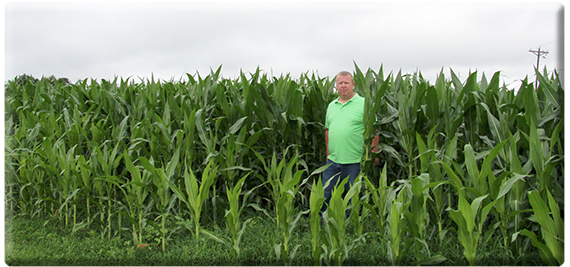Kentucky Ag News

Michael Buckman is farming 200 acres of soybeans and 500 acres of corn this year. (NASS photo by Lisa Ferguson)
Local corn grower sees market stability through NASS surveys
By LISA FERGUSON, National Agricultural Statistics Service Public Affairs
CALVARY, Ky. - The U.S. Department of Agriculture’s National Agricultural Statistics Service (NASS) released its findings June 30 from the June Agricultural Survey conducted in late May and early June. The survey queried nearly 2,600 farms across Kentucky to determine crop acreage for 2016.
“We found the number of acres of corn planted increased seven percent from 2015,” said David Knopf, director of the NASS Eastern Mountain Regional Office in Kentucky. “Acres of soybeans planted was down slightly from last year, but still came in at the second-largest number we’ve seen.”
Kentucky farmers planted an estimated 1.5 million acres of corn, up 100,000 acres from 2015. Farmers in the state planted an estimated 1.8 million acres of soybeans, which was down 40,000 acres from the previous year.
(The U.S. corn planted for all purposes in 2016 was estimated at 94.1 million acres, up seven percent from last year. This represents the third-highest planted acreage in the United States since 1944. U.S. soybean planted area for 2016 was estimated at a record-high 83.7 million acres, up one percent from last year.)
One of those 2,600 farms surveyed earlier this year in Kentucky was Michael Buckman’s farm in Marion County.
Buckman, 39, of Calvary, is a lifelong, many-generation corn and soybean farmer in central Kentucky. He bought his farm from his parents in 2011 and has been running it ever since with his wife, Megan.
“I’ve always been a farmer,” Buckman said. “I’ve either worked for Dad or run the farm my entire life. We can trace our family farming back to the Civil War right here in Calvary.”
Buckman’s family owns more than 500 acres of geographically separated farms in the area and rents land from other landowners. Rental rates rose this year, though, forcing him to cut out 500 acres of his usual production.
“This year, I have 200 acres of soybeans and 500 acres of yellow [non-genetically modified organism] corn,” Buckman said. “I grow the corn for the bourbon industry and have a contract with them, so I cut out 500 acres of soybeans this year when rental prices went up.”
Buckman planted all of his 700 acres this year, but the rainy spring put him six weeks behind his normal schedule, though he should only be two weeks behind by harvest later this year.
“We’ve had plenty of rain to balance out the hot days, so our crop conditions are good,” he said. “This rain over the Fourth of July helped because we were starting to get dry, but now we’re doing pretty good.”
Despite the rainy start to planting and some early hotter-than-usual temperatures, Buckman expects a 1:1 plant-to-harvest ratio this year, which falls in line with his farm’s historical averages. He always harvests all his acres, even in a drought year like 2012, because his insurance policy requires that he harvest even zero-yield acres. He’d much rather get paid for his crop contracts than insurance payouts but realizes weather is one of the unknowns in farming.
Weather isn’t the only uncertainty facing farmers, a fact Buckman knows well from the various agricultural associations he serves on. He’s the treasurer for the Kentucky Corn Growers Association, is on several district boards through the county extension office, and is involved in the Marion County Farm Bureau and the Kentucky Soybean Association. He’s also taken part in the Kentucky Corn Growers Association’s Crop Observation and Research Education (CORE) program, which studies agronomy and modern technologies used in agriculture.
“Market instability is one of the biggest issues facing corn growers,” Buckman said. “We just want a stable market to know what to [generally] expect each year. A young farmer can’t get started because he can’t go out and secure funding with a market that so radically changes every year. That’s where the growers associations really work to offset the market instability and make sure the export market and trade programs are available.”
Buckman sees the importance of NASS survey data assessing yields and values in adding stability to a farmer’s life and answers all those that come across his desk, sometimes answering over the phone instead of filling out the paper survey.
Regardless of the ups and downs of farming, Buckman has no plans of switching careers.
“I love farming,” he said. “When I’m not doing it, I want to be doing it. Even if I have to sit in the tractor for 15 hours a day for two weeks straight, I don’t care. I just love being out there, and it doesn’t matter if it’s a really nice tractor or a really old tractor, although my body doesn’t appreciate older tractors so much anymore.”
When his body needs a rest from hours and days in the tractor, Buckman can be found volunteering with the Knights of Columbus doing fish fries or other events or camping with his wife and three kids along the Rolling Fork River that borders his farm.
To learn more about NASS surveys and corresponding data in Kentucky, visit https://www.nass.usda.gov/Statistics_by_State/Kentucky/. To sign up to be counted in the Census and other surveys, visit https://www.agcounts.usda.gov/cgi-bin/counts/.














